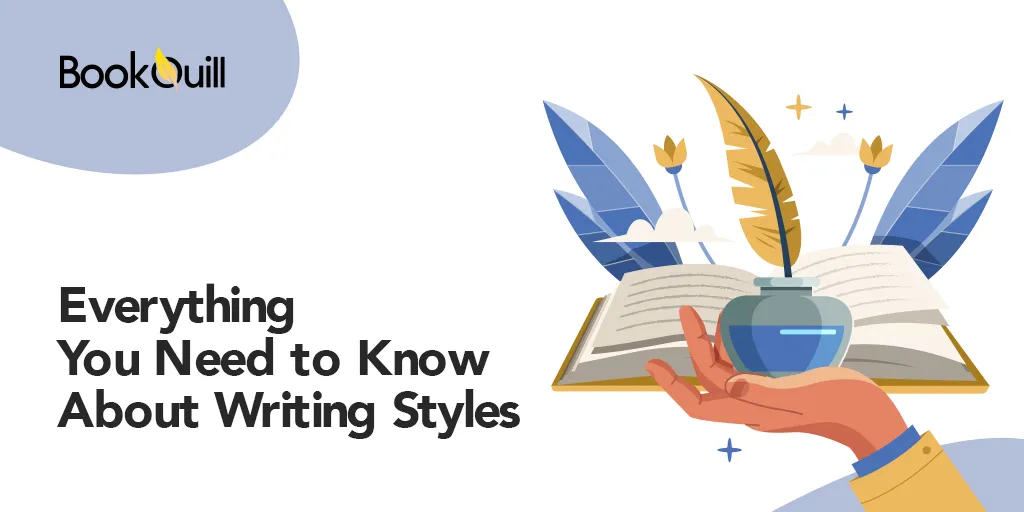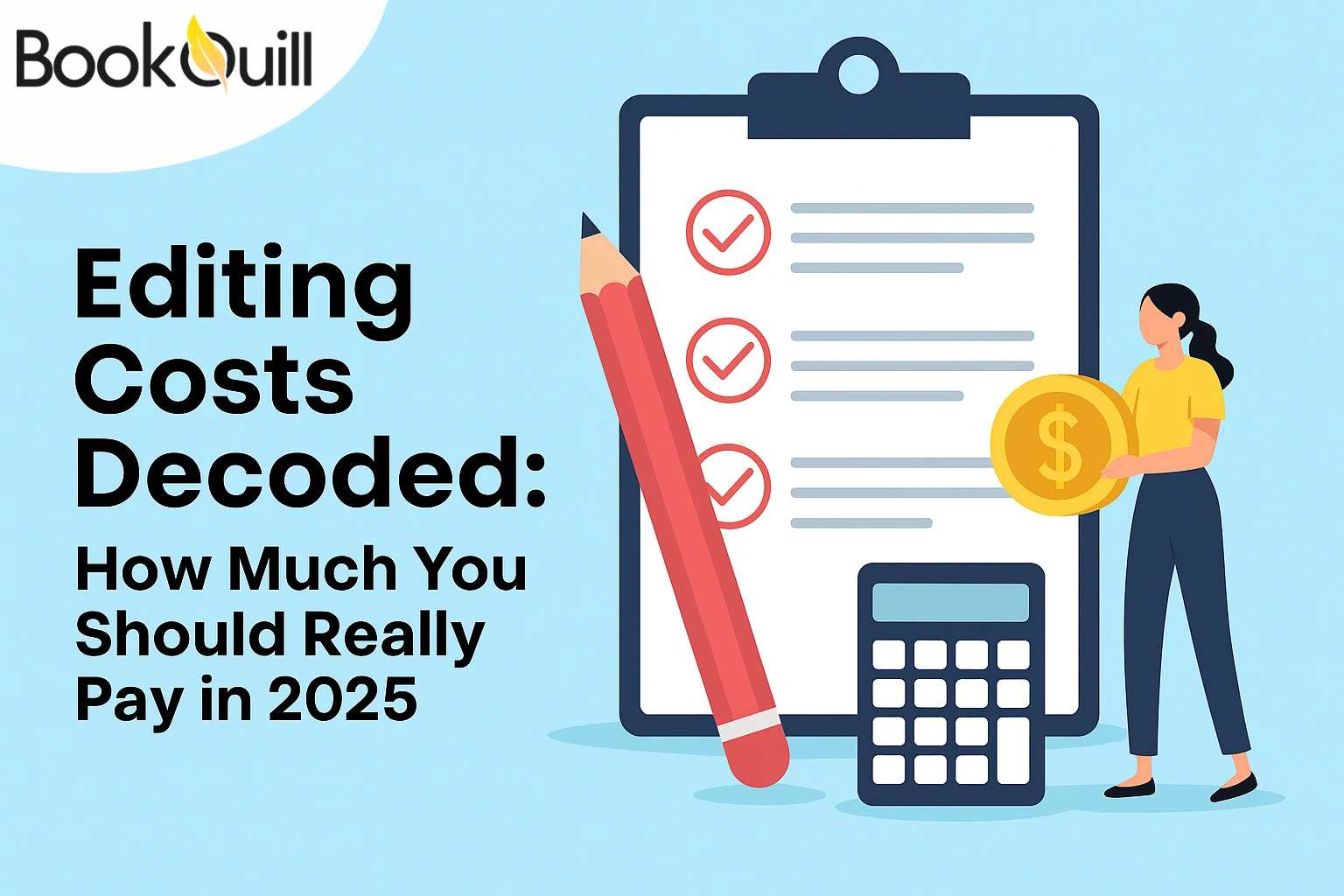Table of Contents
Explore Blogs
Trending on Ebook
Everything You Need to Know About Writing Styles

A person doesn’t have to be a fashion stylist to have a unique fashion style. The same rule applies, if you are a writer. There are some aspects that are distinctive to each person – having a differing writing style is one of them.
After all, the aim is to give a unique spin to the art of storytelling. Or to communication, in general. That’s why developing your own style of writing is essential today.
Though it can be challenging, you have nothing to worry about if you have signed up with BookQuill. Because we make sure to produce content that’s distinctive to your tone and style in writing.
Scroll the blog article below to find out more about these:
A. What is a Writing Style?
A writing style can simply be defined as the method of writing that an author uses the most to express himself. While closely resonating deep with his own personal voice.
Since there are different styles of writing, every author’s creative book writing style varies, depending upon several features.
These include: author’s syntax, word choice, and tone, among other things. Putting it simply, an author’s writing styles is the voice that readers/audiences hear when they read his work.
B. The Different Types of Writing Styles
When it comes to the different kinds of writing styles, each style comes with its own set of features and purpose that define it. While further helping to differentiate it from the others.
However, an author’s writing style depends on several other factors. Such as context, target audience, or simply, the purpose behind the selection of the chosen writing type.
Although, these may seem handful, they can truly make the writer stand apart from the crowd!
For this reason, we have a brief writing styles list that you can incorporate in your work and give your writing a unique flavor of its own:
-
Style #1 – Narrative Writing
All styles of writing come with a temperament of their own. Hence, to find a style that is personal to you, yet stands out in the crowd – does take a lot of practice.
Not to mention, a lot of hard work as well.
Most writers prefer to write in a clear and concise manner, which is uncomplicated to say the least. Such writers prefer to use the narrative writing style, where ideas are skillfully penned down like a story.
These normally involve a plot, some characters, a story plot, and finally, a setting to set the stage for the plot to unravel the sequence of events.
These events can have one perspective or more than two, depending on the writer. The best example of narrative writing can be illustrated in memoirs, autobiographies, novels and even short stories.
The purpose of this style of writing is to recount a range of events to reveal the plot and tell the story.
-
Style #2 – Descriptive Writing
There is no one way to describe descriptive writing style.
This style of writing allows a creative person to truly think out of the box and help them to create and setup a vibrant world, with the power of their pen!
These creative ways to develop your writing style helps writers to express their thoughts, ideas, and creativity to the fullest.
Thus, ensuring that the reader also gets enveloped in the rich cocoon of their words, making it one damn good experience for their senses!
That’s why this style of writing is also known as creative writing. Both names are often used interchangeably.
This just shows that with descriptive writing style, vivid images can be painted via the use of rich audio-visual imagery and figurative language.
Truly elevating the text to another level! Hence, this writing style is ideal if you are writing fiction. And can sparingly be used within non-fiction texts as well.
-
Style #3 – Expository Writing
When an author wants to inform significant info to his audience or wants to explain something, then they choose an expository writing style to write the piece.
What’s more, this kind of text is usually easy to identify. It has a clear intent to focus on a point(s).
With an expository writing style, facts are presented in a straight-forward manner. The writer is not encouraged to state his emotion or personal opinion that’s why it has zero fluff.
The idea is to stick with concrete, factual details as much as possible. An example of this writing style is observed in textbooks, newspaper articles, academic essays and all kinds of reports.
So writers are not encouraged to share their personal opinion about a news story or a new scientific discovery covered in such a report.
Instead, the target audience has to tackle a plethora of data, backed by solid evidence, a diverse range of statistics for a broader audience.
-
Style #4 – Persuasive Writing
The persuasive style of writing is adopted when a writer is inclined towards a specific viewpoint and wants to persuade the reader to endorse the same particular idea.
This kind of writing usually involves texts that use logical reasoning. And stand by an emotionally-charged stance. The content is further backed by opinions to emphasize different points.
And the intention to play really well with the reader’s psychology. That’s why, every argument in a persuasive essay is also backed by social proof.
While the language used, aims to engage the reader optimally, encouraging them to form an emotional connection with the text.
Written material that uses this type of writing style will always display a delicate balance between emotive tones and a rational, analytical voice. The reader will find that this usually begins with the headline that’s grabs attention in an organic manner.
Yet, it is extremely relatable at the same time as well. Hence, this style of writing is often used by marketing teams, editors, PR professionals, advertisers, and in articles across digital and print media.
-
Style #5 – Technical Writing
Another ebook writing style that encourages the writer to be straight-forward and talk to the point. But what makes it stand out is that most of the time, it involves complex data, scientific info, stats, or simply instructions.
Technical writing style is well-suited for written content, where the aim is to convey complex data, scientific information, reports, or manuals, etc.
It is usually adopted by individuals, who are in search of specific data for a specific domain or subject matter. As mentioned before, the idea is to be as clear as possible.
Since such written pieces would also include innumerable technicalities and terminologies, which can only be understood by the person(s) of that particular discipline.
Therefore, it is extremely important that the writer be clear and not use flowery language when working on such pieces!
C. How Do I Know Which Writing Style is Right For Me?
There is no rocket science involved when it comes to choosing the right writing style. Once you are familiar with every one of them, it becomes easier to determine which one best suits your writing needs.
Here’s what you need to consider:
- – Know the purpose of your writing task
- – Identify with it
- – Check that it aligns with basic factors, such as your target audience.
However, what’s crucial is that your writing style RESONATES with your audience. The only way for your task to communicate effectively is via the tone that you choose.
For instance, a research paper would require the writer to adopt a serious and professional tone. Hence, expository writing style would be considered appropriate.
However, you cannot apply the same somber style if writing a children’s book or even ad copy for a tv commercial. For the latter, the writer would have to adopt a fun and light writing tone.
Hence, persuasive writing style would be considered best. That’s why, always pick a writing style, which aligns well with the task for effective communication.
Wrapping It Up,
As we wrap up this article, it is important to point out that while each type of writing style is unique and serves a different purpose, it ultimately depends on the writer and the style they choose.
Most writers prefer to mix various styles together. Thus, producing a written piece that truly belongs to them and is distinctive in its own way.
Whether you are just starting your writing journey or have been in the business for long, always take out some time to explore and experiment with the different types of writing styles.
You may use one writing style for a certain sphere while another may be more appropriate for another. The idea is to convey your ideas effectively while leaving a strong impact on the reader.
Let your writing style come to you and you are good to go!
Frequently Asked Questions (FAQs)
Q. What is writing style?
A writing style is defined by the way a writer forms and arranges sentences, uses descriptions and figurative language along with his word choice to craft a piece of text, true to his voice.
Q. What are some of the major types of writing styles?
Five kinds of writing styles are popular among writers – expository, descriptive, narrative, persuasive, and technical.
Q. Why is it important to understand the different types of writing style?
Whether you are a hobbyist or a professional, understanding different writing styles is quite helpful. One, it conveys the message in an effective and meaningful manner. Two, the text forms a connection with the reader. And three, it allows the writer to experiment with their craft.




